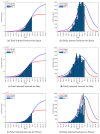An Efficient COVID-19 Prediction Model Validated with the Cases of China, Italy and Spain: Total or Partial Lockdowns?
- PMID: 32443871
- PMCID: PMC7290738
- DOI: 10.3390/jcm9051547
An Efficient COVID-19 Prediction Model Validated with the Cases of China, Italy and Spain: Total or Partial Lockdowns?
Abstract
The present work develops an accurate prediction model of the COVID-19 pandemic, capable not only of fitting data with a high regression coefficient but also to predict the overall infections and the infection peak day as well. The model is based on the Verhulst equation, which has been used to fit the data of the COVID-19 spread in China, Italy, and Spain. This model has been used to predict both the infection peak day, and the total infected people in Italy and Spain. With this prediction model, the overall infections, the infection peak, and date can accurately be predicted one week before they occur. According to the study, the infection peak took place on 23 March in Italy, and on 29 March in Spain. Moreover, the influence of the total and partial lockdowns has been studied, without finding any meaningful difference in the disease spread. However, the infected population, and the rate of new infections at the start of the lockdown, seem to play an important role in the infection spread. The developed model is not only an important tool to predict the disease spread, but also gives some significant clues about the main factors that affect to the COVID-19 spread, and quantifies the effects of partial and total lockdowns as well.
Keywords: COVID-19; China; France; Germany; Italy; SARS-CoV-2; Spain; UK; Verhulst; coronavirus; forecast; model; prediction.
Conflict of interest statement
The authors declare no conflict of interest.
Figures


















References
-
- Smith D. The Palgrave Handbook of Unconventional Risk Transfer. Palgrave Macmillan; London, UK: 2017. Pandemic Risk Modelling; pp. 463–495.
LinkOut - more resources
Full Text Sources
Miscellaneous

